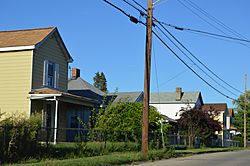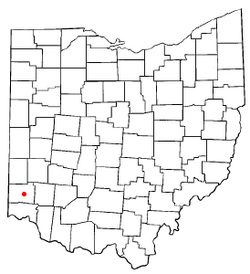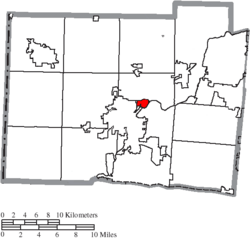New Miami, Ohio facts for kids
Quick facts for kids
New Miami, Ohio
|
|
|---|---|
|
Village
|
|
| Village of New Miami | |

Houses on Augspurger Avenue
|
|

Location of New Miami, Ohio
|
|

Location of New Miami in Butler County
|
|
| Country | United States |
| State | Ohio |
| County | Butler |
| Area | |
| • Total | 0.94 sq mi (2.43 km2) |
| • Land | 0.90 sq mi (2.34 km2) |
| • Water | 0.04 sq mi (0.09 km2) |
| Elevation | 591 ft (180 m) |
| Population
(2020)
|
|
| • Total | 2,217 |
| • Density | 2,452.43/sq mi (946.83/km2) |
| Time zone | UTC-5 (Eastern (EST)) |
| • Summer (DST) | UTC-4 (EDT) |
| ZIP code |
45011 and 45013 West of Four Mile Creek
|
| Area code(s) | 513 |
| FIPS code | 39-55104 |
| GNIS feature ID | 2399475 |
New Miami is a small village in Butler County, Ohio. It is located in the southwestern part of the U.S. state of Ohio. In 2020, about 2,217 people lived there.
New Miami is just north of Hamilton, Ohio. It was once known as Coke Otto, Otto, or Kokotto. This name came from a large coal field and steel mill that used to be in the area. The village is also known for its involvement in a legal case about traffic cameras.
Contents
Village Location and Size
New Miami is a small community. It covers a total area of about 0.94 square miles (2.43 square kilometers). Most of this area is land, with a very small part being water.
How Many People Live Here?
| Historical population | |||
|---|---|---|---|
| Census | Pop. | %± | |
| 1930 | 1,289 | — | |
| 1940 | 1,443 | 11.9% | |
| 1950 | 1,860 | 28.9% | |
| 1960 | 2,360 | 26.9% | |
| 1970 | 3,273 | 38.7% | |
| 1980 | 2,980 | −9.0% | |
| 1990 | 2,555 | −14.3% | |
| 2000 | 2,469 | −3.4% | |
| 2010 | 2,249 | −8.9% | |
| 2020 | 2,217 | −1.4% | |
| U.S. Decennial Census | |||
Population in 2010
In 2010, there were 2,249 people living in New Miami. These people lived in 792 households, with 590 of them being families. The village had about 2,471 people per square mile.
Most of the people living in New Miami were White (92.0%). About 5.2% were African American. A small number of people were Native American, Asian, or from other backgrounds. About 1.2% of the population was Hispanic or Latino.
Many households (39.5%) had children under 18 living with them. The average household had 2.84 people. The average family had 3.22 people. The average age in the village was 36.1 years old.
History of New Miami
Early Days and Industry
New Miami was officially made a village in 1929. Before that, around 1905, a company built many coke ovens in the area. These ovens were used to make a fuel called coke from coal. This is why the area was called Coke Otto. The coke plant was very large, covering about 50 acres (200,000 square meters) and having 120 coke ovens.
Later, in 1937, The American Rolling Mill Company bought the property. This company later changed its name to ARMCO. ARMCO was famous for making "Armco barriers," which are crash barriers used on many auto-racing tracks, especially in Formula One.
Traffic Cameras and Legal Challenges
Around 2013, New Miami started using speed cameras on US-127. These cameras were meant to help manage traffic speed in the village. If someone was caught speeding, they would receive a fine.
However, a judge stopped the camera system in February 2014. The village had collected a lot of money from these fines during the time the cameras were active. In 2015, the village tried a new system where police officers would use the cameras. This new system started in 2016.
A legal case called Barrow v. Village of New Miami happened from 2014 to 2017. This case was about the money the village had collected from the speed camera fines. In the end, the village had to pay back some of the money it had received from the fines.
See also
 In Spanish: New Miami (Ohio) para niños
In Spanish: New Miami (Ohio) para niños

